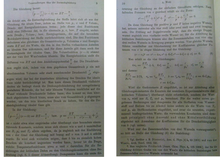
Investigations into the equation of state,
p. 9f., Zeitschr. f. Physically. Chemistry 87
The equation of state of a real gas according to Wohl tries to reproduce the experimental values for as many gases as possible, i.e. to improve the Van der Waals equation without becoming too mathematically complex. It was set up by the chemist Alfred Wohl in 1914 in the article "Investigations on the equation of state" for the journal for physical chemistry (volume 87, pp. 1 to 39) . The range of validity extends from large (molar) volumes to the critical molar volume.
Equation of state without temperature dependence of the attraction
For the pressure , the molar volume (= volume divided by the amount of substance ) and the absolute temperature, the following applies:



(1a) 
or.
(1b) 
The equation for the molar volume is:
(1c) 
 is the universal gas constant and and are parameters that depend on the respective gas.
is the universal gas constant and and are parameters that depend on the respective gas.


The member has the role of attraction between the particles, in the first discussion without temperature dependence, and the member corresponds to the intrinsic volume of the particles and for the (pressure) member, which is new compared to the Van der Waals equation, there is well in its The first article suggests that the irregularly shaped molecules are prevented from rotating as a possible interpretation.



Determination of the parameters from the critical state variables
In order to obtain the parameters and solely from the experimentally easily accessible values of pressure and temperature at the critical point , Wohl assumes in the “first discussion” that the volume at the critical point is a fourfold zero of equation (1c) and compares it thus (1c) with .



At the onset of the critical temperature and the critical pressure, (1c) reads:
(2) 
When comparing coefficients of the powers of :


(3) 
So there are four equations for actually only three unknowns so that a relationship can also be established between the temperature, the pressure and the volume at the critical point, the critical molar volume, which is only uncertainly determinable, is calculated from the critical pressure and the critical temperature. The following applies:

(4) , , ,



Critical compressibility factor
The following applies to the compressibility factor (compression factor) at the critical point: what is (with ) mostly better agreement with the critical compression factors of the gases compared to the compression factor according to the Van der Waals model , the critical compression factor for oxygen is ( O 2 ) 0.288, for nitrogen (N 2 ) 0.292 and for carbon dioxide 0.274.


Reduced form

Isotherms at T = T
c (with V
0 = RT
c / p
c ) according to Wohl's model in comparison with van der Waals and
ideal gas
With the reduced quantities , equation (1a) changes into:

(5) 
As can be seen from the V r -p r diagram of the isotherm at the critical temperature, the equation of state cannot be used for molar volumes below the critical molar volume.
Comparison with Ideal Gas and other models
In order to make the formula independent of the specific gas, one usually relates the pressure, the temperature and the volume to the critical values. Since the critical volume can only be measured imprecisely, in many models (e.g. van-der-Waals, Redlich-Kwong and also in Wohl's model) the volume is calculated using the critical pressure and the critical temperature. The models for the critical molar volume come to different values: with van-der-Waals , with Wohl and with Redlich-Kwong . In order to be able to compare the predictions for the volume, a common reference volume must be used and therefore the volume is selected as the reference volume that would result from and according to the equation of the ideal gas , i.e. or . With and then applies:










- Formula ideal gas:

- Van-der-Waals formula:

- Redlich-Kwong formula:
![{\ displaystyle p_ {r} = {\ frac {T_ {r}} {V_ {r} '- {\ frac {{\ sqrt [{3}] {2}} - 1} {3}}}} - {\ frac {\ frac {1} {9 \ left ({\ sqrt [{3}] {2}} - 1 \ right)}} {{\ sqrt {T_ {r}}} V_ {r} '\ left (V_ {r} '+ {\ frac {{\ sqrt [{3}] {2}} - 1} {3}} \ right)}} \ quad}](https://wikimedia.org/api/rest_v1/media/math/render/svg/556fc9e1ba6daf5dd53d784bff8d9b1d25c8245c)
- Formula of Wohl:

- extended formula of Wohl:

Extensions
Both in the original article from 1914 and in subsequent articles, the model is expanded beyond this first discussion in order to be able to reproduce the behavior of real gases even better; a temperature dependence of the parameters a and c is also taken into account, i.e.
with , where z. Eg for carbon dioxide and hydrogen (H 2 ) is set, and: , , ,







Notes and individual references
-
↑ Technical Thermodynamics: Volume Two (4th edition, W. Schüle, Springer-Verlag, reprint 2013), page 120
-
↑ a b Chemisches Zentralblatt (March 1922, Volume I, No. 11, p. 15)
-
↑ see page 9 above in "Investigations into the equation of state" (1914)
-
↑ Technical data (www.apithailand.com, accessed November 26, 2016)
-
↑ Specific heat enthalpy, entropy and dissociation of technical gases ( E. Justi , Springer-Verlag, 1938 (digitization 2013))
-
↑ see A.Wohl, Zeitschrift für Physikalische Chemie , Volume 99 (1921)








































![{\ displaystyle p_ {r} = {\ frac {T_ {r}} {V_ {r} '- {\ frac {{\ sqrt [{3}] {2}} - 1} {3}}}} - {\ frac {\ frac {1} {9 \ left ({\ sqrt [{3}] {2}} - 1 \ right)}} {{\ sqrt {T_ {r}}} V_ {r} '\ left (V_ {r} '+ {\ frac {{\ sqrt [{3}] {2}} - 1} {3}} \ right)}} \ quad}](https://wikimedia.org/api/rest_v1/media/math/render/svg/556fc9e1ba6daf5dd53d784bff8d9b1d25c8245c)







